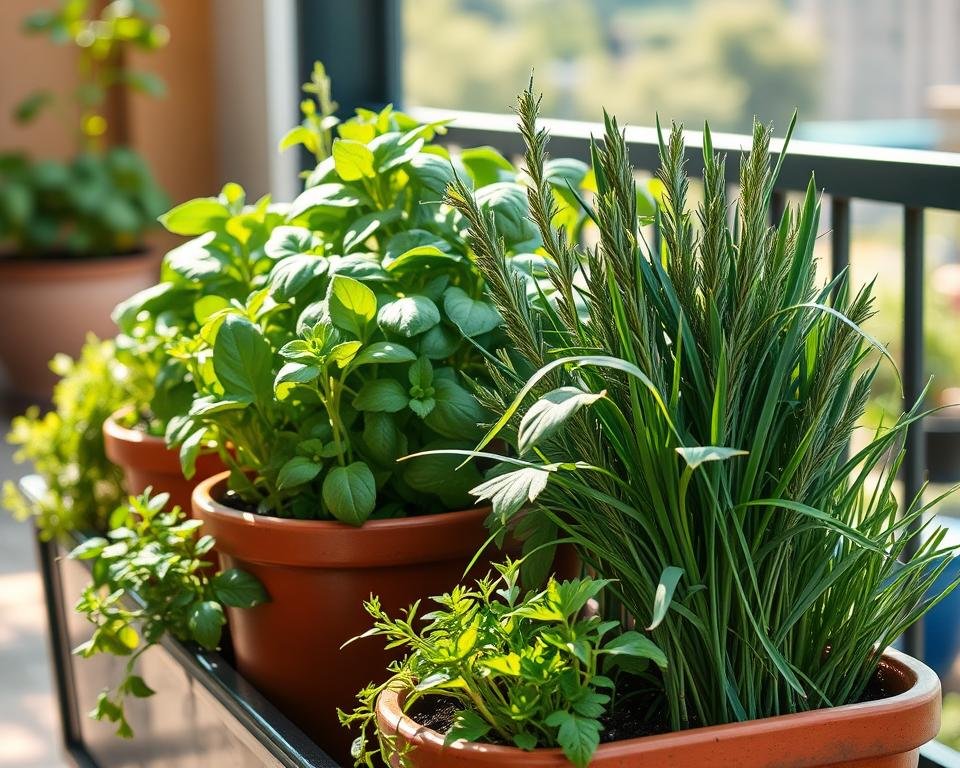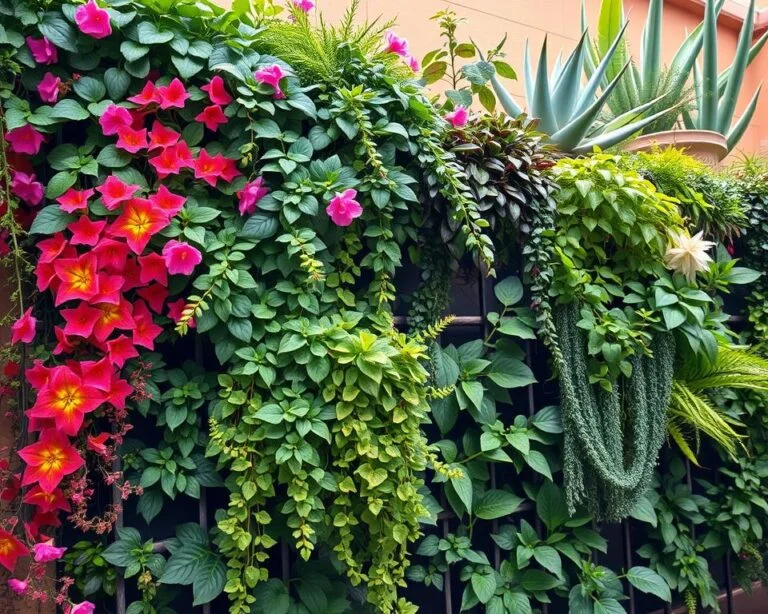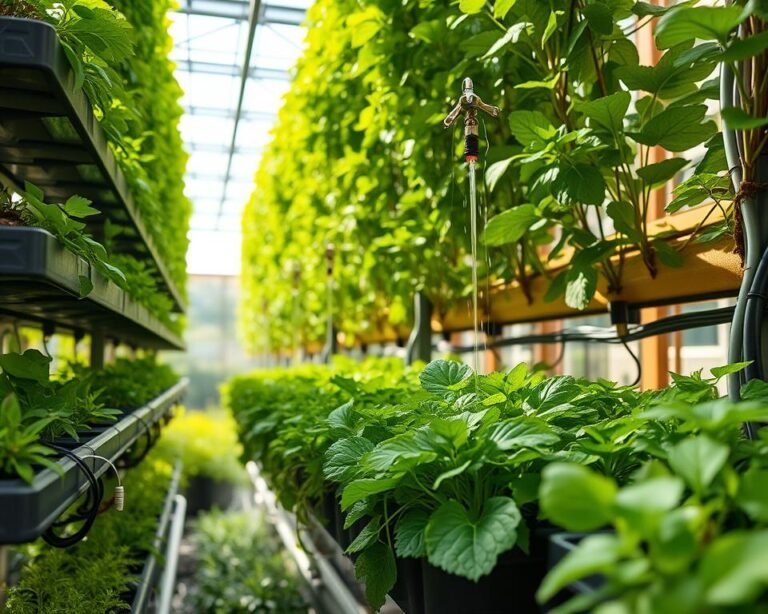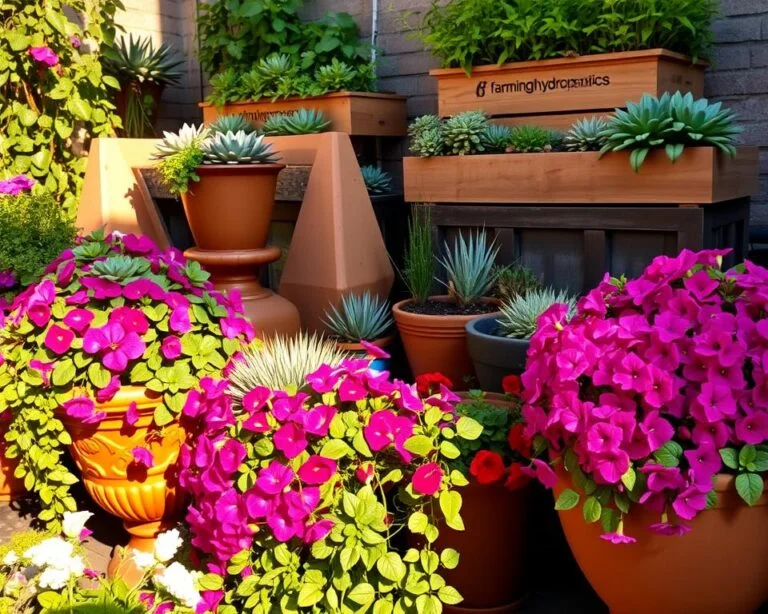Best Culinary Herb Selection for Container Gardens
Growing culinary herbs in containers turned my small urban kitchen into a lively garden. It began as a simple try on my apartment windowsill. But it soon became a big passion that linked me to fresh, homegrown tastes. With the right culinary herb selection, even small spaces can become flavorful havens.
Container gardening is a great choice for those with little space. Even the smallest balcony or kitchen windowsill can become a lush kitchen garden. With 72% of home gardeners choosing container gardening, it’s clear many love this method.
Imagine being just a few steps from your stove to pick fresh basil, parsley, or mint for your dishes. Container herb gardens make this dream come true. They offer both convenience and a deep sense of joy in growing your own food.
Key Takeaways
- Container gardening enables herb cultivation in limited spaces
- Urban gardeners can grow herbs with minimal equipment
- Fresh herbs are easily accessible directly from your kitchen
- Containers help control invasive herb growth
- Container gardens can increase herb yield by up to 20%
Essential Considerations for Container Herb Gardening
Container herb gardening is great for city folks and gardening fans. It lets you grow fresh herbs at home. Whether you have a small balcony or a big patio, herb growing tips can turn your space into a lively kitchen garden.
Starting a herb garden is all about knowing what your plants need. Let’s look at the main things to consider for a successful container herb garden.
Selecting the Perfect Containers
Choosing the right containers is key for growing herbs. Different herbs need different amounts of space:
- Smaller herbs like chives and thyme do well in 6-8 inch pots
- Bigger herbs, like rosemary, need 10-12 inch pots that are at least 12 inches deep
- Make sure each pot has holes for water to drain
Soil and Nutrition Essentials
Creating the right growing spot is vital for herbs. Don’t use regular garden soil in pots. Instead, pick a good potting mix that:
- Drains well
- Has a pH between 6.0 and 7.0
- Has balanced nutrients for healthy herb growth
Mastering Watering and Drainage
Watering needs vary among herbs. Some like their soil always moist, while others do better when it’s drier. Herbs that love water, like basil, need to be watered often. But herbs that can handle dryness, like rosemary and thyme, don’t need as much water.
“The secret to successful container herb gardening is understanding each plant’s unique needs.” – Herb Gardening Experts
By following these tips, you’ll make a perfect spot for your herbs to grow. You’ll have fresh, tasty herbs right at your fingertips.
Culinary Herb Selection for Your Container Garden
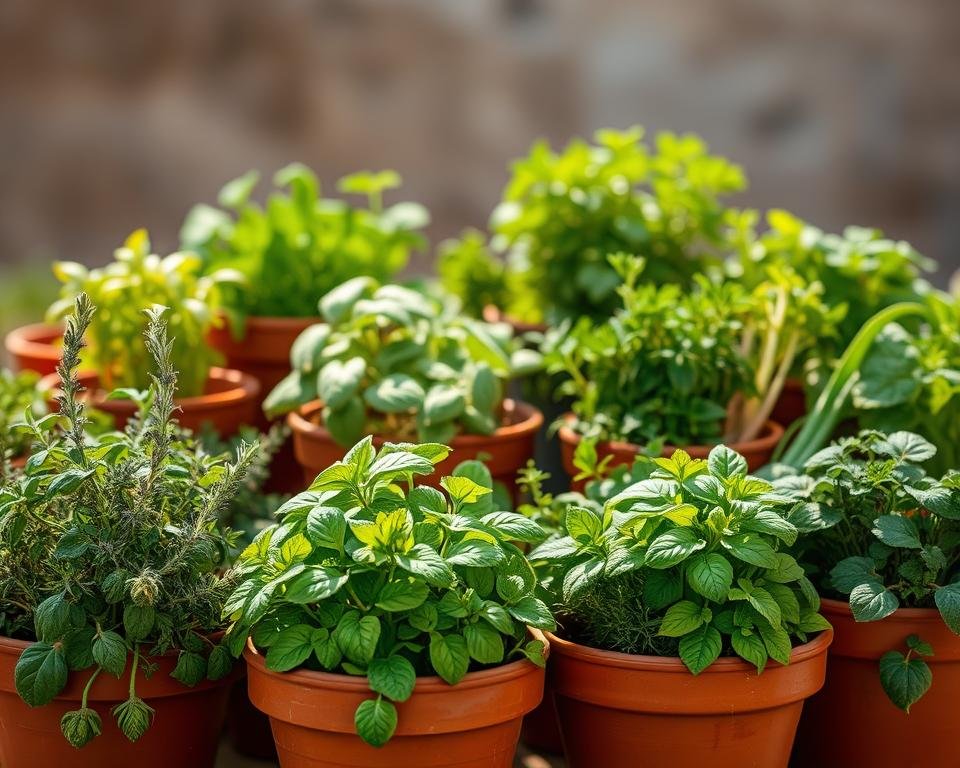
Starting a culinary herb garden in containers is exciting. It begins with knowing your cooking style and what flavors you like. San Antonio’s climate is great for growing many herbs that can make your cooking better.
Think about these popular herbs for your container garden:
- Basil – Perfect for Italian and Thai dishes
- Rosemary – Excellent for Mediterranean cuisine
- Thyme – Versatile herb for multiple cooking styles
- Cilantro – Essential for Mexican and Indian recipes
Choose herbs that match your favorite cuisines. For Mediterranean dishes, pick rosemary, oregano, and thyme. For Mexican flavors, go with cilantro, Mexican oregano, and chives.
Container gardening lets you grow herbs right in your kitchen. You need only 6-12 inches of space to grow herbs. Most herbs need 6-8 hours of sunlight a day, making them great for sunny spots.
Pro tip: Choose herbs that complement each other in both growing conditions and culinary uses for the most successful container garden.
By picking the right herbs, you’ll have a container garden that’s both useful and tasty. It will add fresh, homegrown flavors to your cooking.
Sun and Shade Requirements for Container Herbs
Growing herbs in containers is great for those with little space. Knowing how much light they need is key to growing tasty herbs. Each herb has its own light needs, affecting how well it grows.
When setting up your container herb garden, think about the light each herb needs. Some love full sun, while others do better in partial shade. Choosing the right light for your herbs is crucial for success.
Full Sun Herb Varieties
Full sun herbs need 6-8 hours of direct sunlight every day. These strong plants are great for sunny spots and windowsills.
- Rosemary
- Thyme
- Sage
- Basil
- Oregano
Partial Shade Tolerant Herbs
Some herbs can handle less sunlight, making them perfect for spots with less direct sun.
- Parsley
- Cilantro
- Mint
- Chervil
Indoor Light Requirements
For indoor gardens, artificial lights can help. Grow lights or fluorescent lights can give herbs the light they need.
| Herb Type | Indoor Light Needs | Recommended Hours |
|---|---|---|
| Sun-Loving Herbs | South-facing Window | 6-8 hours |
| Shade-Tolerant Herbs | East or West Window | 4-6 hours |
| Supplemental Grow Lights | Artificial Lighting | 14-16 hours |
Pro tip: Rotate your container herbs often to ensure they get even light. This helps them grow evenly.
Themed Herb Garden Combinations
Creating a themed kitchen garden with culinary herbs can change your container gardening. Herb pairings are not just about taste. They also make your garden look great and work well.
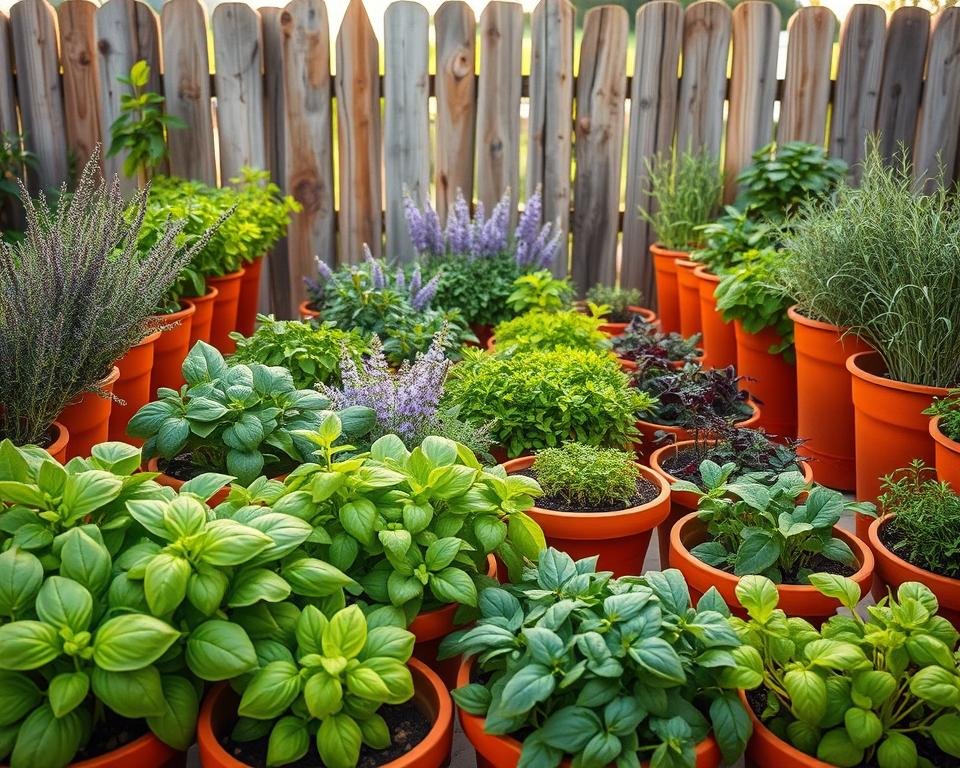
Let’s look at some exciting herb combinations that can make your cooking and garden design better:
Mediterranean Herb Collection
For a Mediterranean-inspired herb garden, focus on these classic herbs:
- Rosemary
- Basil
- Oregano
- Sage
- Thyme
- Lavender
Mexican Culinary Herb Garden
Spice up your container garden with these vibrant Mexican herb pairings:
- Cilantro
- Oregano
- Mint
- Parsley
- Chile peppers
Design Principles for Herb Combinations
When designing your herb garden, use the “thriller, filler, and spiller” principle. This makes your garden look good and use space well.
| Garden Type | Recommended Container Size | Sunlight Requirement |
|---|---|---|
| Mediterranean Herbs | 17 inches tall, 24 inches wide | 6+ hours direct sunlight |
| Vertical Pallet Garden | Accommodates 9 herb types | Minimum 6 hours sunlight |
Your culinary herbs can be both useful and pretty. By picking herbs that go well together and knowing what they need, you’ll have a kitchen garden that looks good and tastes great.
Managing Moisture-Loving and Drought-Resistant Herbs
Knowing how much water each herb needs is key for a great container garden. Each plant has its own water needs. Growing tips for herbs can help your garden grow well.
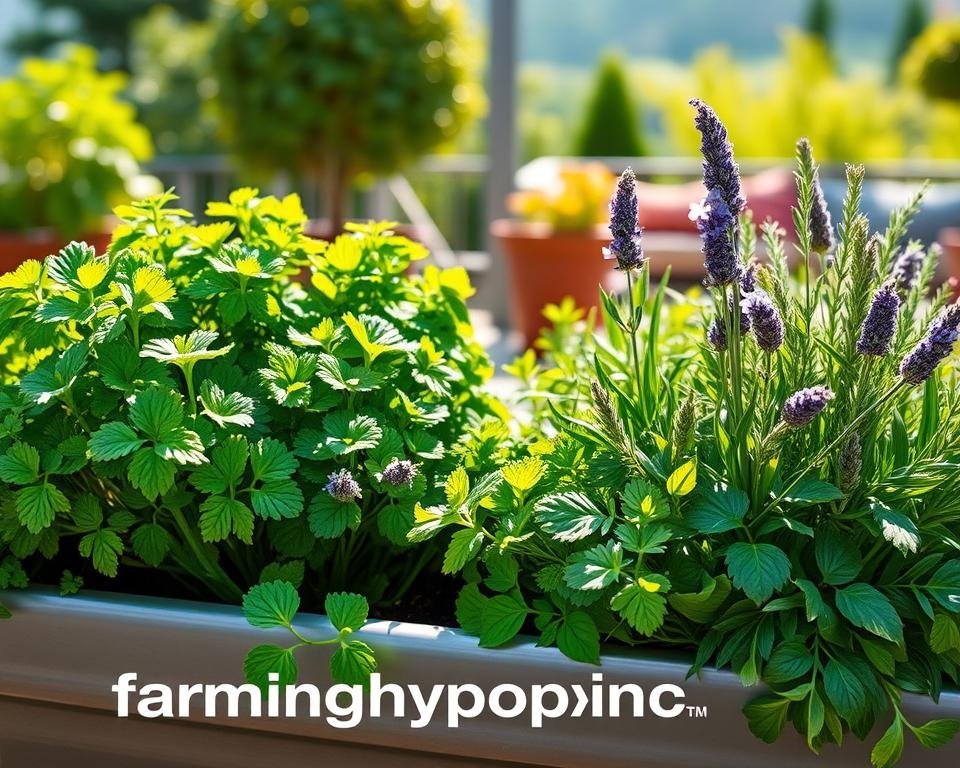
Water-Loving Herb Varieties
Some herbs love moist soil. These include:
- Chives
- Mint
- Cilantro
- Parsley
- Basil
Drought-Tolerant Options
Other herbs do well with less water. They can handle dry spells:
- Rosemary
- Sage
- Thyme
- Lavender
Watering Schedule Tips
Having a good watering plan is important. Here’s a simple guide:
| Herb Type | Watering Frequency | Soil Moisture |
|---|---|---|
| Moisture-Loving Herbs | Every 2-3 days | Consistently moist |
| Drought-Tolerant Herbs | Once per week | Allow soil to dry between waterings |
Container herbs need more water than those in the ground. Watch your plants and change your watering as needed.
Controlling Aggressive Herbs in Containers
In the world of herb gardening, some plants are natural born conquerors. Mint, lemon balm, and anise hyssop are notorious for their aggressive spreading habits. These herbs can quickly transform your container garden from a carefully curated space to an unruly green battlefield.
To manage these vigorous herbs in container gardening, you’ll need strategic growing tips. Consider these effective control methods:
- Use separate containers for aggressive herbs
- Install root barriers to limit underground runners
- Prune frequently to control growth
- Choose compact or dwarf varieties
Mint, for example, sends out tiny runners that form roots and spawn new plants rapidly. These underground networks can quickly overwhelm neighboring herbs if left unchecked. A clever technique involves using a 12-inch pot with its rim slightly above ground level to prevent underground expansion.
“Control your herbs, or they will control your garden” – Herb Gardening Wisdom
While these herbs can be challenging, they’re not without benefits. Many aggressive herbs like mint and lemon balm offer incredible culinary and medicinal uses. The key is managing their growth through careful container gardening techniques.
Conclusion
Growing culinary herbs in containers brings flavor and wellness right to your home. From ancient times to today, herbs are more than just spices. Your container garden can make simple meals special and offer health benefits from medicinal herbs.
Success comes from knowing your growing conditions and choosing the right herbs. Whether it’s basil for flavor or oregano for health, container gardening is for everyone. It’s flexible and easy to start.
Begin with a few herbs, mix different types, and learn as you go. Each container can be a personal garden that meets your taste and health needs. With time and effort, you’ll have fresh herbs that improve your cooking and health.
Your herb gardening journey starts now. Enjoy the flavors, the journey, and the world of container herb gardening!

